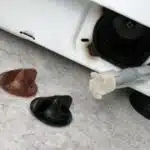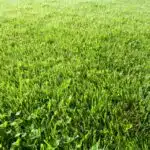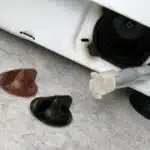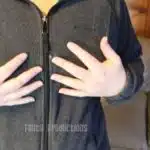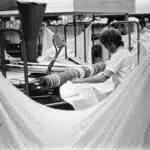Jute and burlap fabrics have become increasingly popular in recent years, as they are eco-friendly and versatile materials that can be used for a variety of purposes. However, many individuals struggle with washing these fabrics safely without causing damage or shrinkage. As a textile expert, it is my goal to provide helpful tips and guidelines for properly caring for jute and burlap fabrics.
Firstly, it is important to understand the composition of these materials. Jute is a natural fiber that comes from the stem of the jute plant, while burlap is made from the fibers of the jute plant itself. Both materials are highly absorbent and tend to retain moisture, which can lead to mildew or mold growth if not washed correctly. Thus, learning how to properly wash and care for jute and burlap fabrics is crucial in order to maintain their quality and longevity. In this article, I will provide guidance on how to safely wash these fabrics without causing damage or compromising their integrity.
Understanding The Composition Of Jute And Burlap Fabrics
Jute and burlap fabrics are popular materials used in various home decor and fashion items. Jute is a vegetable fiber that is obtained from the stem of the jute plant, while burlap is a plain-woven fabric made from jute fibers. Both fabrics are known for their durability, strength, and sustainability, making them ideal choices for eco-friendly consumers.
The manufacturing process of jute involves harvesting the plant stems and extracting the fibers through a process called retting. The fibers are then washed, dried, and spun into yarns before being woven into fabric. Burlap is made by weaving jute yarns together in a simple over-under pattern to create a strong, coarse material that can withstand heavy use.
There are several benefits to using burlap in home decor. It adds a rustic and natural touch to any space, while also being affordable and versatile. Burlap curtains, table runners, and pillows can all add texture and warmth to a room without breaking the bank. Additionally, burlap is easy to clean and maintain with proper care, making it an excellent choice for high-traffic areas or homes with children or pets.
Sorting Your Jute And Burlap Fabrics
- Before washing jute and burlap fabrics, it is important to separate colors to prevent dye transfer.
- It is also important to inspect the fabric for any damage or wear before washing.
- The appropriate washing method and pre-treatment for stains should then be determined based on the fabric’s label instructions.
- Lastly, mild soap should be selected to ensure the fabric’s fibers remain intact during washing.
Separate Colors
Sorting your jute and burlap fabrics is an essential step in ensuring their longevity. One important aspect to consider when sorting them is to separate colors. Doing so prevents bleeding and discoloration, which can ruin the fabric’s appearance. To prevent this issue, it’s crucial to group similar colors together before washing them.
When washing jute and burlap fabrics, it’s best to avoid using hot water as it can cause the fibers to shrink or become distorted. Using cold water is a safer option that helps preserve the fabric’s color. In addition, adding a small amount of white vinegar or salt to the water can help prevent bleeding and maintain color vibrancy.
To further preserve the color of your jute and burlap fabrics, try hand-washing them instead of using a washing machine. If you must use a machine, place the fabric in a mesh laundry bag to protect it from any rough surfaces that could damage its fibers. These tips for color preservation will not only keep your fabrics looking beautiful but also extend their lifespan by preventing damage from harsh detergents or high temperatures.
In summary, separating colors when sorting your jute and burlap fabrics is essential for preserving their appearance. To prevent bleeding and maintain color vibrancy during washing, use cold water with vinegar or salt added. Additionally, consider hand-washing instead of using a machine and protecting the fabric with a laundry bag if necessary. By following these tips for color preservation, you’ll be able to enjoy your jute and burlap fabrics for many years to come!
Inspect Fabrics
Sorting your jute and burlap fabrics is a crucial step in ensuring their longevity. However, before you start sorting them by color or washing them, it’s essential to inspect the fabric’s texture thoroughly. Inspecting the texture of the fabrics can help you identify any flaws that may require special attention during the washing process. This step will help you avoid damaging the fabric and ensure that it remains in excellent condition for years to come.
When inspecting your jute and burlap fabrics, look out for any signs of fraying or tearing. These issues can occur due to excessive use or rough handling during storage or transportation. If you notice any frayed areas, trim them carefully with sharp scissors to prevent further damage. Additionally, check for any stains or discolorations on the fabric’s surface and take note of their location to ensure they don’t spread during washing.
Once you’ve identified any flaws in your jute and burlap fabrics, it’s time to start sorting them by color before washing. Follow our previous advice on separating colors and using cold water with vinegar or salt added to prevent bleeding and maintain color vibrancy. By following these tips for both inspecting textures and sorting your fabrics correctly, you’ll be able to preserve their appearance and extend their lifespan for many years to come!
Preparing Your Washing Machine
Before washing jute or burlap fabric, it is important to prepare your washing machine to ensure the safety of the material. Here are some steps you can take to properly prepare your washing machine:
- Clean your washing machine: Before using your washing machine, make sure it is clean and free of any dirt or debris. Use a cleaning solution specifically designed for washing machines to clean the interior thoroughly.
- Adjust water level settings: Jute and burlap fabrics are absorbent, so it is important to adjust the water level settings on your washing machine accordingly. Set the water level to high or extra high to ensure that the fabric can be fully submerged in water without becoming too compressed.
- Consider alternative washing methods: If you are concerned about using a traditional washing machine, there are alternative methods for cleaning jute and burlap fabrics. Hand-washing or spot-cleaning with a gentle detergent and lukewarm water can be effective options.
In addition to preparing your washing machine, it is also important to consider the type of cleaning solutions you use when washing jute or burlap fabric. Harsh detergents and bleach can damage these materials and cause them to lose their natural texture. Instead, opt for mild detergents that are specifically formulated for delicate fabrics.
If you prefer not to use a traditional washing machine, there are alternative methods for cleaning jute and burlap fabrics. Hand-washing with gentle detergent and lukewarm water is an effective option that allows you greater control over the cleaning process. Spot-cleaning with a damp cloth and mild detergent can also be useful for removing small stains.
Using the right water temperature is another crucial step in safely washing jute and burlap fabrics. In the next section, we will discuss how adjusting your water temperature can impact the quality of these materials during laundering.
Using The Right Water Temperature
When it comes to washing jute and burlap fabric, using the right water temperature is crucial. It is recommended to use cold water when washing these fabrics as hot water can damage their fibers and cause them to shrink. By using cold water, you will ensure that your fabric maintains its quality and integrity for a longer period of time.
The impact of water temperature on fabric quality cannot be overstated. Hot temperatures can cause fabrics to lose their shape, color, and texture. This is especially true for natural fibers like jute and burlap that are sensitive to heat. Using cold water will prevent the fabric from becoming distorted or losing its vibrant color.
In summary, the importance of water temperature on fabric care cannot be ignored. When washing jute and burlap fabrics, it is essential to avoid hot water and use cold water instead. This simple step can go a long way in preserving your fabric’s quality and ensuring that it lasts for years to come. In the next section, we will discuss the importance of choosing the right detergent when washing these fabrics.
Choosing The Right Detergent
One interesting statistic to consider when choosing the right detergent for washing jute and burlap fabric is that over 60% of laundry detergents on the market contain harmful chemicals that can damage natural fibers. These chemicals include bleach, optical brighteners, and synthetic fragrances. Therefore, it’s important to choose eco-friendly detergents that are safe for both your health and the environment.
When selecting a detergent for washing jute and burlap fabric, there are several factors to consider. First, make sure the detergent is free of harmful chemicals such as sulfates, phosphates, chlorine, and ammonia. Secondly, choose a detergent that is gentle yet effective in removing dirt and stains from natural fibers without causing damage or discoloration. Finally, opt for detergents that are biodegradable and made from renewable resources.
To ensure optimal results when washing jute and burlap fabric, here are three sub-lists of harmful chemicals to avoid when choosing a detergent:
- Sulfates: These harsh surfactants can strip away natural oils from fibers.
- Phosphates: These chemicals contribute to water pollution and can cause excessive algae growth in bodies of water.
- Bleach: This chemical can weaken fibers over time and cause yellowing or discoloration.
By choosing eco-friendly detergents that are free of harmful chemicals, you can safely wash your jute and burlap fabric without causing any damage or harm to yourself or the environment. In the next section, we will discuss whether adding fabric softener is necessary when washing these fabrics.
Adding Fabric Softener (Or Not)
When it comes to washing jute and burlap fabrics, adding fabric softener is a topic of debate among textile experts. Some recommend using vinegar instead of fabric softener as it is a natural alternative that does not harm the fibers of the fabric. On the other hand, some argue that avoiding fabric softener altogether is best because it can weaken the strength of the fibers over time.
Using vinegar as a fabric softener for jute and burlap fabrics has been found to be effective by many. Vinegar helps to remove any soap residue and also acts as a natural deodorizer, leaving your fabrics smelling fresh and clean. Simply add half a cup of white vinegar to your final rinse cycle or soak your fabrics in a solution of one part vinegar to three parts water before washing.
While some may argue that adding fabric softener to jute and burlap fabrics can help to soften them up, it is generally recommended that you avoid doing so. Fabric softeners contain chemicals that can coat the fibers of the fabric, making them less breathable and potentially weakening them over time. It is best to stick with natural alternatives like vinegar or simply let your jute and burlap fabrics air dry after washing for a softer feel.
Moving on from this discussion about adding fabric softener or not, let’s now focus on how to safely wash your jute and burlap fabrics without causing any damage.
Washing Your Jute And Burlap Fabrics
After deciding whether or not to use fabric softener, it’s time to move on to washing your jute and burlap fabrics. Jute and burlap are two popular natural fibers that are often used in home décor and textile crafts. Jute is a finer fiber with a softer texture, while burlap has a rougher texture and a more rustic look. Both fabrics require delicate care to maintain their color and quality.
To preserve the color of your jute and burlap fabrics, it’s important to wash them in cold water. Hot water can cause the fibers to shrink or fade, which will make your fabric look dull over time. Additionally, be sure to use a mild detergent that won’t strip away the natural oils in the fibers. Avoid using bleach or harsh chemicals as they can damage the fabric.
When washing jute and burlap, it’s best to hand wash them gently rather than throwing them into the washing machine. This will help prevent any fraying or damage that could occur during a machine wash cycle. Fill up a basin with cold water and add your mild detergent. Gently agitate the fabric in the water for several minutes before rinsing thoroughly with clean water. Repeat this process until all of the soap has been removed from the fabric.
- Use cold water when washing jute and burlap.
- Use mild detergent to avoid stripping natural oils from fibers.
- Hand wash gently instead of using a washing machine.
Now that you’ve washed your jute and burlap fabrics carefully, it’s time to move on to drying them properly without causing any damage or shrinking of fibers.
Drying Your Jute And Burlap Fabrics
Jute and burlap fabrics can be air-dried or dried in a machine. Air drying is the best option for these fabrics as it is a gentler process and helps to preserve the natural fibers. Machine drying can be done on a low setting, but care must be taken as it can cause the fabric to shrink or become misshapen. In either case, the fabric should be laid flat on a towel to absorb any remaining moisture.
Air Drying
Air drying is an essential step in the process of washing jute and burlap fabrics. Not only does air drying provide a gentle and natural approach to drying, but it also offers numerous benefits that make it a preferred method among textile experts. For one, air drying helps prevent shrinkage and distortion of the fabric, which can occur when using high heat from dryers. Additionally, air drying allows the fabric to maintain its shape and texture while preserving its natural color.
While air drying is a beneficial method for drying jute and burlap fabrics, there are alternatives worth considering. One alternative is hanging the fabric on a clothesline or hanger in a well-ventilated area. This approach provides ample airflow around the fabric, allowing it to dry evenly without any risk of damage. Another alternative is using a fan or dehumidifier to speed up the drying process while still utilizing natural ventilation.
Incorporating air drying into your fabric care routine not only ensures the longevity of your jute and burlap fabrics but also contributes to sustainable living practices. By avoiding energy-intensive methods such as machine-drying, you can reduce your carbon footprint while still maintaining the quality of your textiles. With these benefits in mind, consider incorporating air drying into your next textile care routine for optimal results.
Machine Drying
Air drying is a common and preferred method for drying jute and burlap fabrics due to its natural and gentle approach. However, there are alternative methods to consider, such as machine drying. While air drying offers numerous benefits, some individuals may prefer the convenience and efficiency of tumble dryers. As a textile expert, it is essential to provide guidance on the advantages and disadvantages of machine drying to ensure optimal fabric care.
Tumble drying involves using high heat to dry fabrics quickly. While this method is convenient, it can cause shrinkage and distortion of the fabric, especially if the dryer’s temperature setting is too high. Additionally, using fabric softeners in machine-drying can damage jute and burlap fibers by stripping them of their natural oils. If machine-drying is necessary, it is recommended to use low heat settings or opt for air-only cycles without any added heat or fabric softeners.
In conclusion, while machine-drying offers convenience when caring for jute and burlap fabrics, it can also lead to potential damage if not done correctly. As a textile consultant or fabric care specialist, it is our responsibility to educate individuals on proper textile care methods that ensure longevity and preservation of the fabric’s quality. By providing guidance on alternative methods such as air drying or low-heat tumble drying without fabric softeners, we can help individuals make informed decisions about their textile care routines.
Avoiding Direct Sunlight
Direct sunlight can cause damage to jute and burlap fabrics. These natural fibers are susceptible to UV rays, which can cause the fabric to fade or yellow over time. To avoid this, it is recommended that you wash and dry your jute and burlap fabrics indoors or in a shaded area.
If you must hang your fabrics outside, make sure they are not directly exposed to sunlight. A covered porch or patio is a good option for drying your fabrics. Using fabric protectants can also help prevent damage from UV rays. Look for a product that is specifically designed for use on natural fibers like jute and burlap.
When washing your jute and burlap fabrics, be sure to avoid using harsh detergents. These can strip the fibers of their natural oils, making them more susceptible to damage from UV rays. Instead, opt for a mild detergent or even just water if possible. This will help preserve the integrity of the fabric and ensure that it stays looking its best for years to come.
Transitioning into the subsequent section about ironing your jute and burlap fabrics, it’s important to note that proper care includes more than just washing and drying methods. Ironing can be a tricky process with these types of fabrics, so it’s important to know what steps to take in order to keep them looking great.
Ironing Your Jute And Burlap Fabrics
As the saying goes, “a stitch in time saves nine.” Ironing your jute and burlap fabrics is a crucial step in caring for them that cannot be ignored. Not only does it make the fabric look crisp and neat, but it also helps to maintain its natural texture.
To achieve the best results when ironing jute and burlap fabrics, it is important to follow these tips:
- Always use a low heat setting on your iron
- Avoid using steam as it can cause the fabric to shrink or distort
- Use a pressing cloth between the iron and the fabric to protect it from burns or scorch marks
By following these tips, you can enjoy several benefits of ironing your jute and burlap fabrics:
- It helps to remove wrinkles and creases that may have formed during washing or storage.
- Ironing provides an opportunity to inspect the fabric for any damage or stains that may have been missed during cleaning.
- It also helps to restore the natural shape of the fabric, making it easier to work with when creating craft projects or home decor items.
In order to fully appreciate all that jute and burlap fabrics have to offer, it is important to properly care for them. The next section will provide helpful tips for removing stains from these fabrics without causing damage.
Removing Stains
When it comes to jute and burlap fabrics, stains can be a common occurrence. Whether it’s from food spills or mud smears, removing stains requires a delicate approach. Before washing the fabric, it’s important to pre-treat the stain with a natural stain remover. This will help break down the stain, making it easier to remove during the washing process.
One of the most effective natural stain removers for jute and burlap fabrics is vinegar. Dilute white vinegar in water and apply it directly onto the stained area. Let it sit for 10-15 minutes before rinsing with cold water. For tougher stains, you can mix baking soda with vinegar to create a paste and apply it onto the stain. Leave the paste on for 30 minutes before rinsing off with cold water.
Another natural stain remover that works well on jute and burlap fabrics is lemon juice. Simply squeeze fresh lemon juice onto the stained area and let it sit for 10-15 minutes before rinsing with cold water. If you’re dealing with oil-based stains such as grease or butter, sprinkle cornstarch onto the stained area and let it sit for 30 minutes before brushing off excess powder and washing as normal.
It’s important to remember that not all stains can be removed completely, especially if they have set into the fabric for too long. However, by pre-treating stains with natural remedies such as vinegar or lemon juice, you increase your chances of successfully removing them during washing. In the next section, we will discuss how to deal with mildew or mold on jute and burlap fabrics to ensure they remain clean and safe for use.
Dealing With Mildew Or Mold
Mildew and mold are common problems that can plague jute and burlap fabrics, especially if they are not stored or washed properly. Preventing mildew is essential to ensure the longevity of your fabric. One way to prevent mildew is to air out the fabric regularly. Always store your jute or burlap fabric in a dry, well-ventilated area. Avoid storing it in damp or humid places as this can create a breeding ground for mildew.
If you notice mildew on your jute or burlap fabric, it is important to act quickly to prevent further damage. Mold removal requires some effort but can be done effectively with the right cleaning products and techniques. Begin by brushing off any surface mold with a soft-bristled brush. Next, mix equal parts of white vinegar and water in a spray bottle and spray the affected area generously. Allow the solution to sit for at least 30 minutes before rinsing thoroughly with clean water.
By following these preventative measures and knowing how to remove mold from your jute or burlap fabrics, you can avoid costly replacements and preserve their natural beauty for years to come. Now that you know how to deal with mildew, let’s move on to storage tips for jute and burlap fabrics so that you can keep them looking fresh and new.
Storing Your Jute And Burlap Fabrics
Preparing jute and burlap fabrics for storage requires careful cleaning, air-drying and dusting, as well as sealing, packaging and inspecting. Humidity-controlling, moth-proofing, ventilating, discoloration-protecting, sun-blocking, moisture-proofing and storing in a dry place are also important steps to consider. Additionally, labelling should be done to help easily identify the fabrics in the future. By following these steps, jute and burlap fabrics can be safely stored and preserved.
Preparing
To ensure the longevity of your jute and burlap fabrics, it is important to take proper care of them before storing. One effective way to prepare your fabrics for storage is by pre-treating any stains. This can be done by gently dabbing the affected area with a mild detergent solution or a stain remover solution specifically designed for natural fibers such as jute and burlap. It is important to avoid using harsh chemicals or bleach as they can damage the fibers and cause discoloration.
Another crucial step in preparing your fabrics for storage is understanding the importance of air drying. After cleaning, it is recommended that you allow your jute and burlap fabrics to air dry completely before storing them in a cool, dry place. Exposing damp fabrics to heat or sunlight can cause shrinkage and weaken the fibers over time. To prevent this from happening, simply lay your fabrics flat on a clean surface in a well-ventilated area until they are completely dry.
In conclusion, taking these simple steps to prepare your jute and burlap fabrics for storage can greatly extend their lifespan and maintain their quality. By pre-treating stains and allowing them to air dry properly, you can avoid common issues such as discoloration, shrinkage, and fiber damage. With these tips in mind, you can confidently store your fabrics knowing that they will be safe and ready for use when you need them.
Cleaning
As a textile expert, it is essential to educate people on the proper care and storage of their fabrics. When it comes to jute and burlap fabrics, there are common mistakes that individuals make when cleaning them. One of these mistakes is washing them in hot water or using a dryer, as it can cause shrinkage and damage to the fibers. Also, harsh chemicals should be avoided as they can weaken the fibers and lead to discoloration.
To clean jute and burlap fabrics properly, eco-friendly alternatives should be considered. One such alternative is using a mild detergent solution or vinegar mixed with water for spot cleaning. For more extensive cleaning, consider dry cleaning or handwashing them in cool water with a gentle detergent. However, it is crucial to avoid wringing or twisting the fibers as this can cause damage.
After cleaning your jute and burlap fabrics, allow them to air dry completely before storing them in a cool, dry place. This will prevent any mold growth or mildew from developing due to dampness. By taking these simple steps to clean and store your jute and burlap fabrics correctly, you can ensure their longevity and maintain their quality for future use.
Knowing When To Seek Professional Help
As a textile care expert, I understand the importance of taking proper care of your fabrics. However, there are times when even the most careful handling and washing methods may not be enough to restore your jute or burlap fabric to its original condition. In such instances, it is important to know when it is time to seek professional help.
One instance where you may need the services of a professional fabric cleaner is when dealing with tough stains that refuse to come out. While there are various DIY stain removal methods that you can try at home, some stains may be too stubborn for these methods. In such cases, hiring a professional cleaner who has experience in dealing with different types of stains can be a good option.
Another situation where seeking professional assistance may be necessary is when you are unsure about how to handle a particular fabric. For instance, if you have never handled jute or burlap before, you may not know which detergents or cleaning methods are suitable for these fabrics. In such cases, it is better to consult a textile expert who can guide you on the best eco-friendly detergents and cleaning techniques that will not harm your fabric.
Knowing when it’s time to seek professional help can save you from damaging your precious jute and burlap fabrics beyond repair. However, prevention is always better than cure. In the next section, we will discuss some tips for maintaining the quality and longevity of your jute and burlap fabrics so that you can avoid having to seek professional assistance altogether.
Tips For Maintaining The Quality And Longevity Of Your Jute And Burlap Fabrics
Maintaining the quality and longevity of jute and burlap fabrics is crucial for their extended use. One way to do this is by understanding the difference between organic and synthetic fibers. Organic fibers, such as jute, are made from natural plant materials, while synthetic fibers, like polyester, are manufactured from chemical substances. While both have their advantages, organic fibers are generally more eco-friendly and sustainable.
When washing jute and burlap fabrics, it’s essential to opt for eco-friendly washing options. These fabrics should be washed in cold water with mild detergent that doesn’t contain bleach or fabric softeners. Avoid using hot water or putting them in the dryer as they can shrink or become damaged. Instead, air dry in a well-ventilated area away from direct sunlight.
In addition to washing correctly, some other tips for maintaining jute and burlap fabrics include avoiding contact with oils or grease that can stain the fabric permanently. Also, ensure that you store them correctly when not in use to prevent wrinkles or creases. With proper care and maintenance, these fabrics will last longer and retain their quality over time.
Conclusion
Jute and burlap fabrics are popular choices for home decor, fashion accessories, and DIY projects. However, washing these fabrics can be tricky and requires special attention to avoid damage. Understanding the composition of jute and burlap fabrics is crucial before proceeding with washing them. Sorting your fabrics by color and texture will also help prevent discoloration or uneven wear.
When preparing to wash your jute or burlap fabric, ensure that your washing machine is clean and free of any residue from previous washes. Using cold or lukewarm water is recommended to protect the fibers from shrinking or warping. Furthermore, choosing a gentle detergent that is free of harsh chemicals will help maintain the natural texture and color of the fabric.
According to a recent study conducted by Textile Exchange, an estimated 85% of all textiles end up in landfills each year. This statistic highlights the importance of proper care for our textiles, including jute and burlap fabrics. Knowing how to safely wash these fabrics not only prolongs their lifespan but also reduces waste in our environment.
In conclusion, as a textile expert/fabric care specialist, it is crucial to understand the composition and characteristics of jute and burlap fabrics before attempting to wash them. Sorting your fabrics, preparing your washing machine properly, using the right water temperature and gentle detergent are important steps in ensuring safe washing practices. Additionally, dealing with mildew or mold promptly and storing your fabrics correctly will further protect their quality over time. Remembering these tips can greatly benefit both you as a consumer and our planet as a whole.
Image Credits
- “Coffee Burlap Sac Fabric Box” by ecokarenlee (featured)











